Organizational Leadership: Core Theories, Leadership Styles and Group Dynamics
VerifiedAdded on 2023/06/10
|12
|2774
|217
AI Summary
This article provides an overview of organizational leadership, including core theories, leadership styles, and group dynamics. It discusses trait theory, behavioral theory, contingency theory, participative theory, management theory, and relationship theory. It also explores situational, transformational, and transactional leadership styles and their practical applications. The article concludes with a discussion on the importance of choosing the right leadership style for a group's success.
Contribute Materials
Your contribution can guide someone’s learning journey. Share your
documents today.
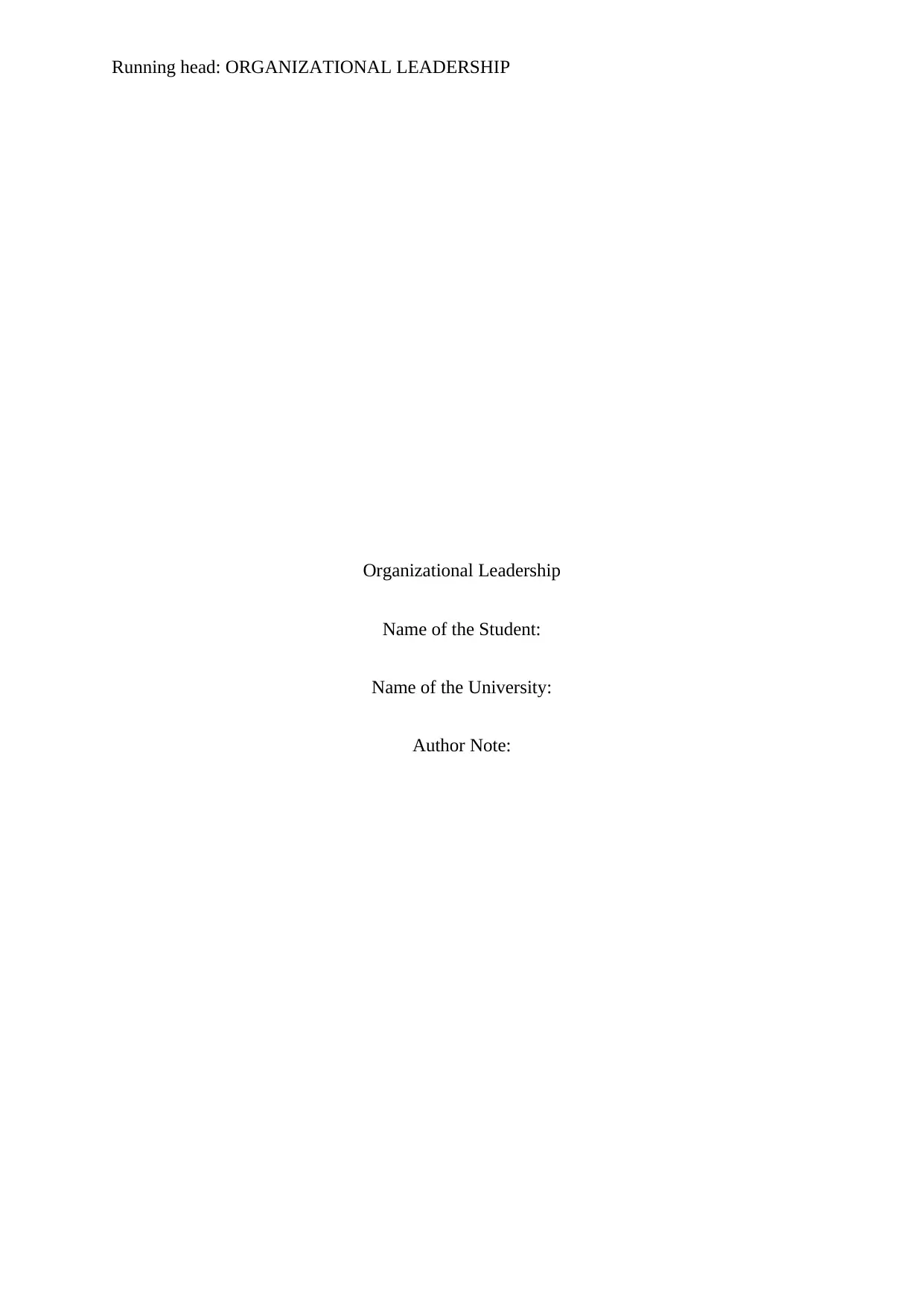
Running head: ORGANIZATIONAL LEADERSHIP
Organizational Leadership
Name of the Student:
Name of the University:
Author Note:
Organizational Leadership
Name of the Student:
Name of the University:
Author Note:
Secure Best Marks with AI Grader
Need help grading? Try our AI Grader for instant feedback on your assignments.

1ORGANIZATIONAL LEADERSHIP
Introduction:
The article gives an overview on organizational leadership in the perspective of the
practical applications of group theory. The article reviews the core leadership theories and the
leadership styles along with group dynamics. The article therefore puts forward a selection of
the major theories of leadership believed to provide foundations for better and newer group
level theories of leadership. This includes trait theory, behavioral theory, contingency theory,
participative theory, management theory and relationship theory. It is found that leaders of
groups believe in maintaining four leadership functions which include management of
interpersonal dynamics within group, coordination of resources/information within group,
management of the group level effect and management of the group boundaries for group
identity and the resource/ information flow. The article also puts forward a discussion on the
situational, transformational and the transactional leadership styles and the group dynamics.
The article will also ensure the choice of the leadership style that will guide the group
towards success. The article is supported by quotations and shows how each of the theory has
a practical application.
Discussion:
Core Theories of Group
Trait Theory is based on the assumption that individuals inherit certain traits and
qualities that makes them better suited for leadership (Antonakis & House, 2013). This
theory often helps in identifying the behavioral characteristics or personality shared by the
leaders. Traits refer to the external behavior that emerges from the thoughts going in
someone’s mind. These internal process and belief acts important for an effective leadership.
The trait theory however finds practical application in determining the trait approach
used for the personal development and awareness through the analysis of weakness and
strength in gaining better understanding of the traits (Antonakis & Day, 2017). The theory
Introduction:
The article gives an overview on organizational leadership in the perspective of the
practical applications of group theory. The article reviews the core leadership theories and the
leadership styles along with group dynamics. The article therefore puts forward a selection of
the major theories of leadership believed to provide foundations for better and newer group
level theories of leadership. This includes trait theory, behavioral theory, contingency theory,
participative theory, management theory and relationship theory. It is found that leaders of
groups believe in maintaining four leadership functions which include management of
interpersonal dynamics within group, coordination of resources/information within group,
management of the group level effect and management of the group boundaries for group
identity and the resource/ information flow. The article also puts forward a discussion on the
situational, transformational and the transactional leadership styles and the group dynamics.
The article will also ensure the choice of the leadership style that will guide the group
towards success. The article is supported by quotations and shows how each of the theory has
a practical application.
Discussion:
Core Theories of Group
Trait Theory is based on the assumption that individuals inherit certain traits and
qualities that makes them better suited for leadership (Antonakis & House, 2013). This
theory often helps in identifying the behavioral characteristics or personality shared by the
leaders. Traits refer to the external behavior that emerges from the thoughts going in
someone’s mind. These internal process and belief acts important for an effective leadership.
The trait theory however finds practical application in determining the trait approach
used for the personal development and awareness through the analysis of weakness and
strength in gaining better understanding of the traits (Antonakis & Day, 2017). The theory
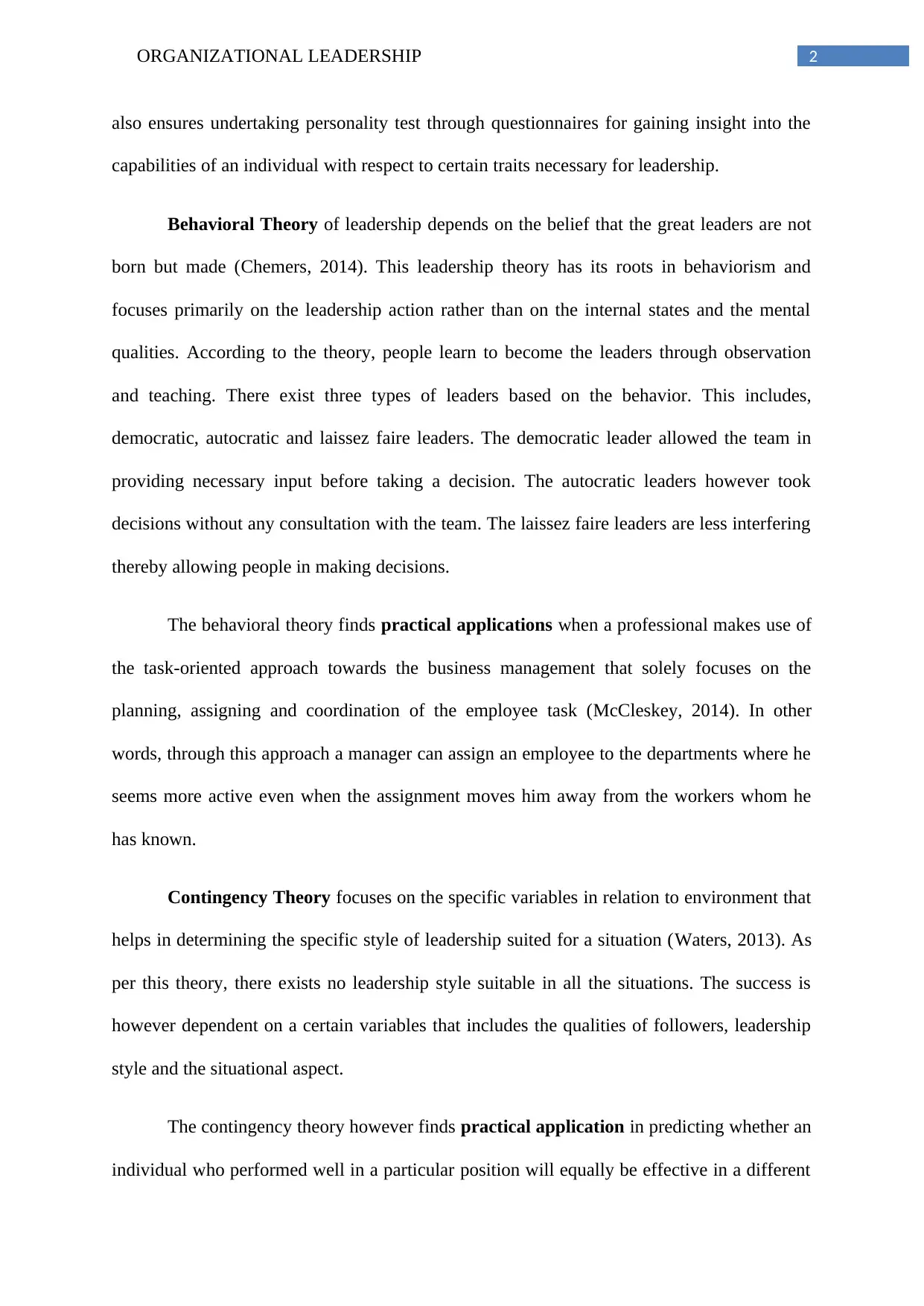
2ORGANIZATIONAL LEADERSHIP
also ensures undertaking personality test through questionnaires for gaining insight into the
capabilities of an individual with respect to certain traits necessary for leadership.
Behavioral Theory of leadership depends on the belief that the great leaders are not
born but made (Chemers, 2014). This leadership theory has its roots in behaviorism and
focuses primarily on the leadership action rather than on the internal states and the mental
qualities. According to the theory, people learn to become the leaders through observation
and teaching. There exist three types of leaders based on the behavior. This includes,
democratic, autocratic and laissez faire leaders. The democratic leader allowed the team in
providing necessary input before taking a decision. The autocratic leaders however took
decisions without any consultation with the team. The laissez faire leaders are less interfering
thereby allowing people in making decisions.
The behavioral theory finds practical applications when a professional makes use of
the task-oriented approach towards the business management that solely focuses on the
planning, assigning and coordination of the employee task (McCleskey, 2014). In other
words, through this approach a manager can assign an employee to the departments where he
seems more active even when the assignment moves him away from the workers whom he
has known.
Contingency Theory focuses on the specific variables in relation to environment that
helps in determining the specific style of leadership suited for a situation (Waters, 2013). As
per this theory, there exists no leadership style suitable in all the situations. The success is
however dependent on a certain variables that includes the qualities of followers, leadership
style and the situational aspect.
The contingency theory however finds practical application in predicting whether an
individual who performed well in a particular position will equally be effective in a different
also ensures undertaking personality test through questionnaires for gaining insight into the
capabilities of an individual with respect to certain traits necessary for leadership.
Behavioral Theory of leadership depends on the belief that the great leaders are not
born but made (Chemers, 2014). This leadership theory has its roots in behaviorism and
focuses primarily on the leadership action rather than on the internal states and the mental
qualities. According to the theory, people learn to become the leaders through observation
and teaching. There exist three types of leaders based on the behavior. This includes,
democratic, autocratic and laissez faire leaders. The democratic leader allowed the team in
providing necessary input before taking a decision. The autocratic leaders however took
decisions without any consultation with the team. The laissez faire leaders are less interfering
thereby allowing people in making decisions.
The behavioral theory finds practical applications when a professional makes use of
the task-oriented approach towards the business management that solely focuses on the
planning, assigning and coordination of the employee task (McCleskey, 2014). In other
words, through this approach a manager can assign an employee to the departments where he
seems more active even when the assignment moves him away from the workers whom he
has known.
Contingency Theory focuses on the specific variables in relation to environment that
helps in determining the specific style of leadership suited for a situation (Waters, 2013). As
per this theory, there exists no leadership style suitable in all the situations. The success is
however dependent on a certain variables that includes the qualities of followers, leadership
style and the situational aspect.
The contingency theory however finds practical application in predicting whether an
individual who performed well in a particular position will equally be effective in a different
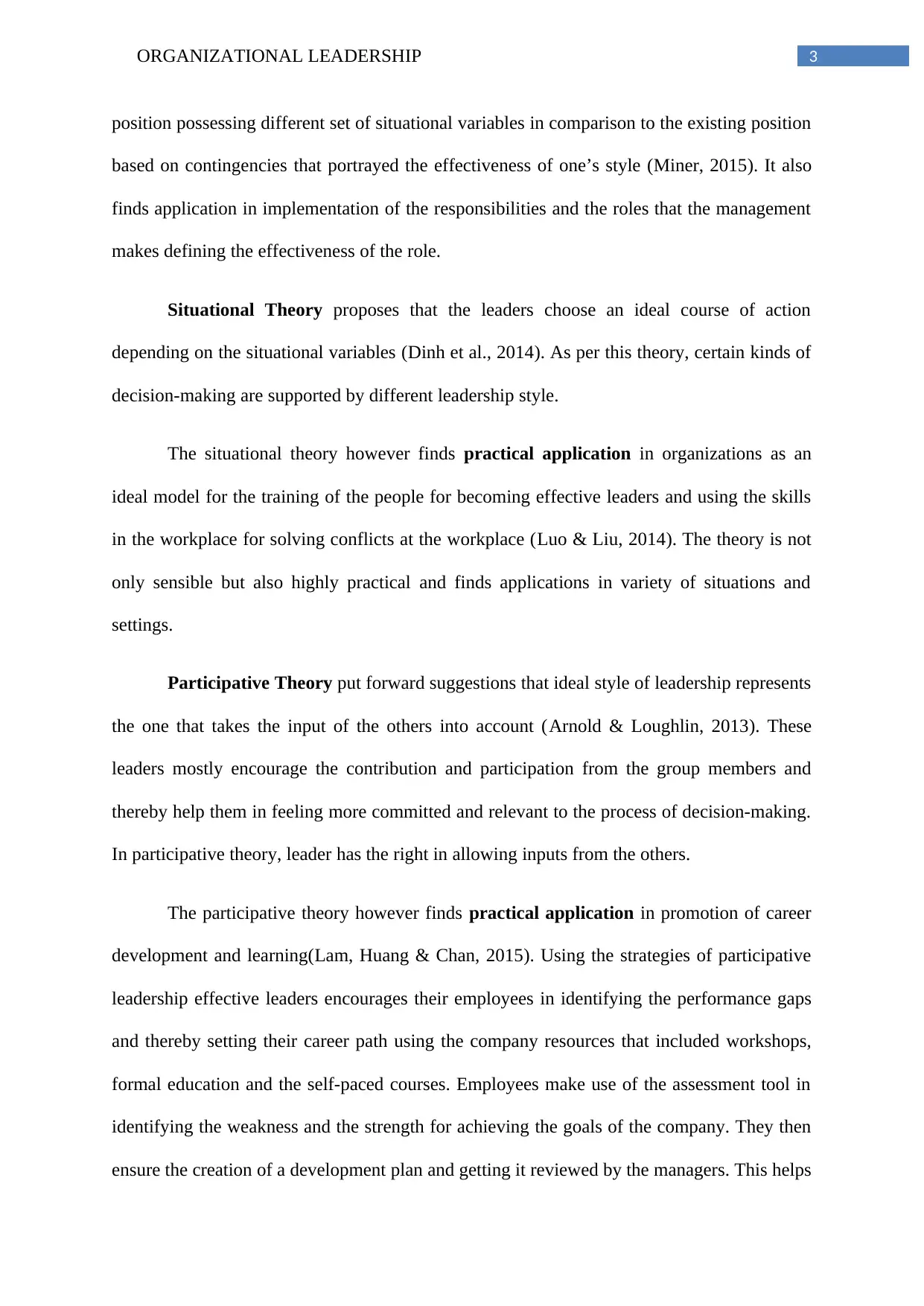
3ORGANIZATIONAL LEADERSHIP
position possessing different set of situational variables in comparison to the existing position
based on contingencies that portrayed the effectiveness of one’s style (Miner, 2015). It also
finds application in implementation of the responsibilities and the roles that the management
makes defining the effectiveness of the role.
Situational Theory proposes that the leaders choose an ideal course of action
depending on the situational variables (Dinh et al., 2014). As per this theory, certain kinds of
decision-making are supported by different leadership style.
The situational theory however finds practical application in organizations as an
ideal model for the training of the people for becoming effective leaders and using the skills
in the workplace for solving conflicts at the workplace (Luo & Liu, 2014). The theory is not
only sensible but also highly practical and finds applications in variety of situations and
settings.
Participative Theory put forward suggestions that ideal style of leadership represents
the one that takes the input of the others into account (Arnold & Loughlin, 2013). These
leaders mostly encourage the contribution and participation from the group members and
thereby help them in feeling more committed and relevant to the process of decision-making.
In participative theory, leader has the right in allowing inputs from the others.
The participative theory however finds practical application in promotion of career
development and learning(Lam, Huang & Chan, 2015). Using the strategies of participative
leadership effective leaders encourages their employees in identifying the performance gaps
and thereby setting their career path using the company resources that included workshops,
formal education and the self-paced courses. Employees make use of the assessment tool in
identifying the weakness and the strength for achieving the goals of the company. They then
ensure the creation of a development plan and getting it reviewed by the managers. This helps
position possessing different set of situational variables in comparison to the existing position
based on contingencies that portrayed the effectiveness of one’s style (Miner, 2015). It also
finds application in implementation of the responsibilities and the roles that the management
makes defining the effectiveness of the role.
Situational Theory proposes that the leaders choose an ideal course of action
depending on the situational variables (Dinh et al., 2014). As per this theory, certain kinds of
decision-making are supported by different leadership style.
The situational theory however finds practical application in organizations as an
ideal model for the training of the people for becoming effective leaders and using the skills
in the workplace for solving conflicts at the workplace (Luo & Liu, 2014). The theory is not
only sensible but also highly practical and finds applications in variety of situations and
settings.
Participative Theory put forward suggestions that ideal style of leadership represents
the one that takes the input of the others into account (Arnold & Loughlin, 2013). These
leaders mostly encourage the contribution and participation from the group members and
thereby help them in feeling more committed and relevant to the process of decision-making.
In participative theory, leader has the right in allowing inputs from the others.
The participative theory however finds practical application in promotion of career
development and learning(Lam, Huang & Chan, 2015). Using the strategies of participative
leadership effective leaders encourages their employees in identifying the performance gaps
and thereby setting their career path using the company resources that included workshops,
formal education and the self-paced courses. Employees make use of the assessment tool in
identifying the weakness and the strength for achieving the goals of the company. They then
ensure the creation of a development plan and getting it reviewed by the managers. This helps
Secure Best Marks with AI Grader
Need help grading? Try our AI Grader for instant feedback on your assignments.
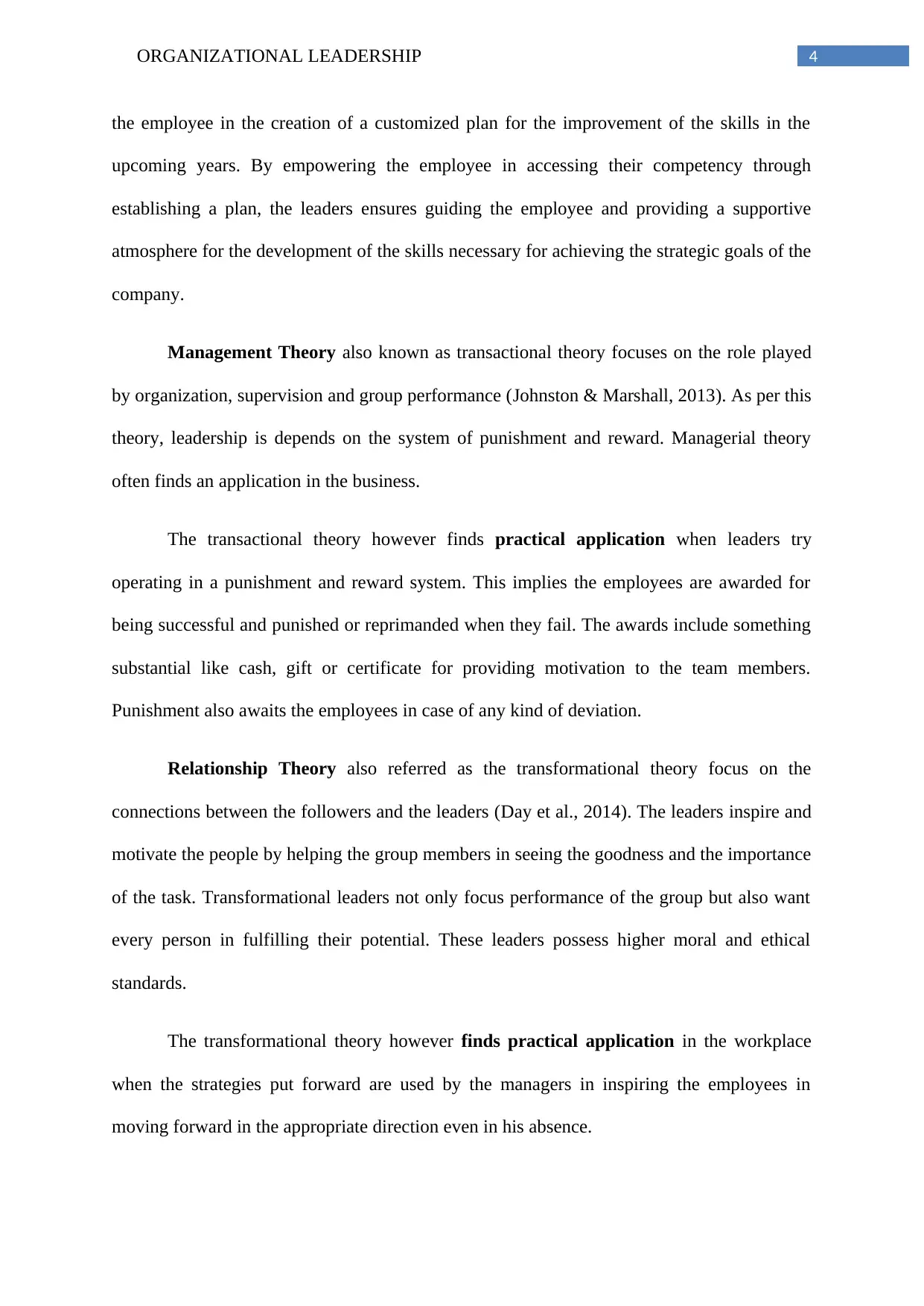
4ORGANIZATIONAL LEADERSHIP
the employee in the creation of a customized plan for the improvement of the skills in the
upcoming years. By empowering the employee in accessing their competency through
establishing a plan, the leaders ensures guiding the employee and providing a supportive
atmosphere for the development of the skills necessary for achieving the strategic goals of the
company.
Management Theory also known as transactional theory focuses on the role played
by organization, supervision and group performance (Johnston & Marshall, 2013). As per this
theory, leadership is depends on the system of punishment and reward. Managerial theory
often finds an application in the business.
The transactional theory however finds practical application when leaders try
operating in a punishment and reward system. This implies the employees are awarded for
being successful and punished or reprimanded when they fail. The awards include something
substantial like cash, gift or certificate for providing motivation to the team members.
Punishment also awaits the employees in case of any kind of deviation.
Relationship Theory also referred as the transformational theory focus on the
connections between the followers and the leaders (Day et al., 2014). The leaders inspire and
motivate the people by helping the group members in seeing the goodness and the importance
of the task. Transformational leaders not only focus performance of the group but also want
every person in fulfilling their potential. These leaders possess higher moral and ethical
standards.
The transformational theory however finds practical application in the workplace
when the strategies put forward are used by the managers in inspiring the employees in
moving forward in the appropriate direction even in his absence.
the employee in the creation of a customized plan for the improvement of the skills in the
upcoming years. By empowering the employee in accessing their competency through
establishing a plan, the leaders ensures guiding the employee and providing a supportive
atmosphere for the development of the skills necessary for achieving the strategic goals of the
company.
Management Theory also known as transactional theory focuses on the role played
by organization, supervision and group performance (Johnston & Marshall, 2013). As per this
theory, leadership is depends on the system of punishment and reward. Managerial theory
often finds an application in the business.
The transactional theory however finds practical application when leaders try
operating in a punishment and reward system. This implies the employees are awarded for
being successful and punished or reprimanded when they fail. The awards include something
substantial like cash, gift or certificate for providing motivation to the team members.
Punishment also awaits the employees in case of any kind of deviation.
Relationship Theory also referred as the transformational theory focus on the
connections between the followers and the leaders (Day et al., 2014). The leaders inspire and
motivate the people by helping the group members in seeing the goodness and the importance
of the task. Transformational leaders not only focus performance of the group but also want
every person in fulfilling their potential. These leaders possess higher moral and ethical
standards.
The transformational theory however finds practical application in the workplace
when the strategies put forward are used by the managers in inspiring the employees in
moving forward in the appropriate direction even in his absence.
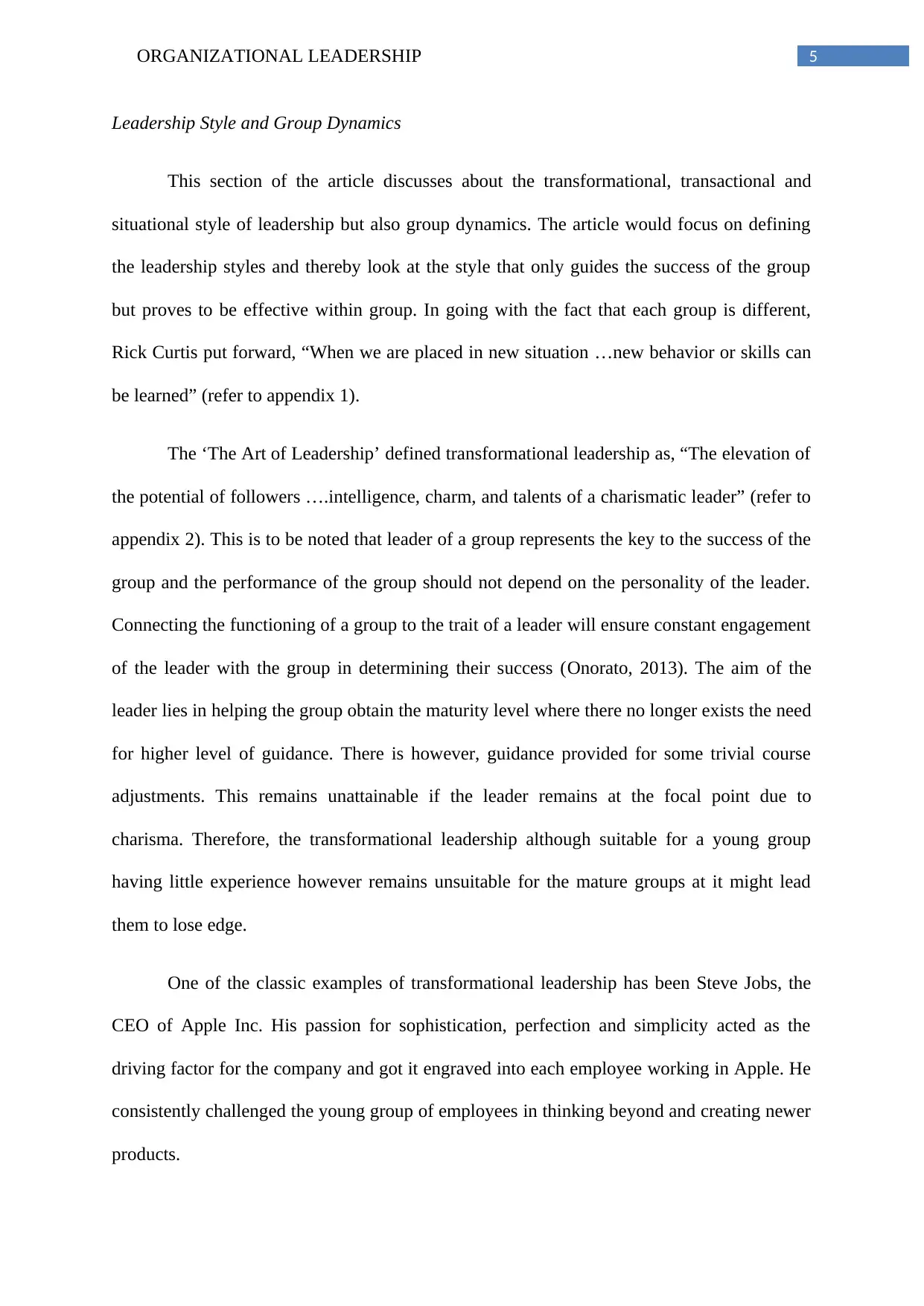
5ORGANIZATIONAL LEADERSHIP
Leadership Style and Group Dynamics
This section of the article discusses about the transformational, transactional and
situational style of leadership but also group dynamics. The article would focus on defining
the leadership styles and thereby look at the style that only guides the success of the group
but proves to be effective within group. In going with the fact that each group is different,
Rick Curtis put forward, “When we are placed in new situation …new behavior or skills can
be learned” (refer to appendix 1).
The ‘The Art of Leadership’ defined transformational leadership as, “The elevation of
the potential of followers ….intelligence, charm, and talents of a charismatic leader” (refer to
appendix 2). This is to be noted that leader of a group represents the key to the success of the
group and the performance of the group should not depend on the personality of the leader.
Connecting the functioning of a group to the trait of a leader will ensure constant engagement
of the leader with the group in determining their success (Onorato, 2013). The aim of the
leader lies in helping the group obtain the maturity level where there no longer exists the need
for higher level of guidance. There is however, guidance provided for some trivial course
adjustments. This remains unattainable if the leader remains at the focal point due to
charisma. Therefore, the transformational leadership although suitable for a young group
having little experience however remains unsuitable for the mature groups at it might lead
them to lose edge.
One of the classic examples of transformational leadership has been Steve Jobs, the
CEO of Apple Inc. His passion for sophistication, perfection and simplicity acted as the
driving factor for the company and got it engraved into each employee working in Apple. He
consistently challenged the young group of employees in thinking beyond and creating newer
products.
Leadership Style and Group Dynamics
This section of the article discusses about the transformational, transactional and
situational style of leadership but also group dynamics. The article would focus on defining
the leadership styles and thereby look at the style that only guides the success of the group
but proves to be effective within group. In going with the fact that each group is different,
Rick Curtis put forward, “When we are placed in new situation …new behavior or skills can
be learned” (refer to appendix 1).
The ‘The Art of Leadership’ defined transformational leadership as, “The elevation of
the potential of followers ….intelligence, charm, and talents of a charismatic leader” (refer to
appendix 2). This is to be noted that leader of a group represents the key to the success of the
group and the performance of the group should not depend on the personality of the leader.
Connecting the functioning of a group to the trait of a leader will ensure constant engagement
of the leader with the group in determining their success (Onorato, 2013). The aim of the
leader lies in helping the group obtain the maturity level where there no longer exists the need
for higher level of guidance. There is however, guidance provided for some trivial course
adjustments. This remains unattainable if the leader remains at the focal point due to
charisma. Therefore, the transformational leadership although suitable for a young group
having little experience however remains unsuitable for the mature groups at it might lead
them to lose edge.
One of the classic examples of transformational leadership has been Steve Jobs, the
CEO of Apple Inc. His passion for sophistication, perfection and simplicity acted as the
driving factor for the company and got it engraved into each employee working in Apple. He
consistently challenged the young group of employees in thinking beyond and creating newer
products.
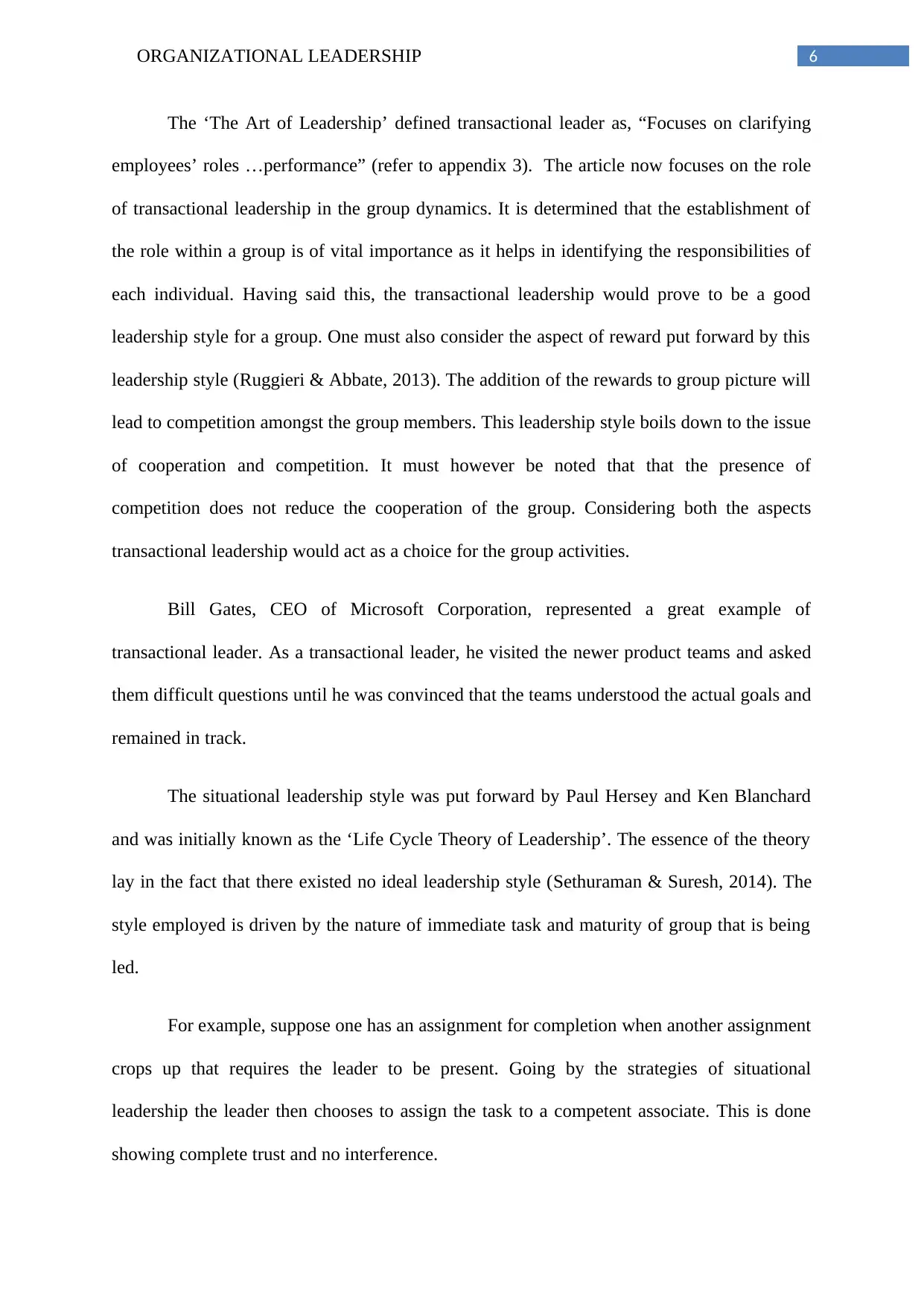
6ORGANIZATIONAL LEADERSHIP
The ‘The Art of Leadership’ defined transactional leader as, “Focuses on clarifying
employees’ roles …performance” (refer to appendix 3). The article now focuses on the role
of transactional leadership in the group dynamics. It is determined that the establishment of
the role within a group is of vital importance as it helps in identifying the responsibilities of
each individual. Having said this, the transactional leadership would prove to be a good
leadership style for a group. One must also consider the aspect of reward put forward by this
leadership style (Ruggieri & Abbate, 2013). The addition of the rewards to group picture will
lead to competition amongst the group members. This leadership style boils down to the issue
of cooperation and competition. It must however be noted that that the presence of
competition does not reduce the cooperation of the group. Considering both the aspects
transactional leadership would act as a choice for the group activities.
Bill Gates, CEO of Microsoft Corporation, represented a great example of
transactional leader. As a transactional leader, he visited the newer product teams and asked
them difficult questions until he was convinced that the teams understood the actual goals and
remained in track.
The situational leadership style was put forward by Paul Hersey and Ken Blanchard
and was initially known as the ‘Life Cycle Theory of Leadership’. The essence of the theory
lay in the fact that there existed no ideal leadership style (Sethuraman & Suresh, 2014). The
style employed is driven by the nature of immediate task and maturity of group that is being
led.
For example, suppose one has an assignment for completion when another assignment
crops up that requires the leader to be present. Going by the strategies of situational
leadership the leader then chooses to assign the task to a competent associate. This is done
showing complete trust and no interference.
The ‘The Art of Leadership’ defined transactional leader as, “Focuses on clarifying
employees’ roles …performance” (refer to appendix 3). The article now focuses on the role
of transactional leadership in the group dynamics. It is determined that the establishment of
the role within a group is of vital importance as it helps in identifying the responsibilities of
each individual. Having said this, the transactional leadership would prove to be a good
leadership style for a group. One must also consider the aspect of reward put forward by this
leadership style (Ruggieri & Abbate, 2013). The addition of the rewards to group picture will
lead to competition amongst the group members. This leadership style boils down to the issue
of cooperation and competition. It must however be noted that that the presence of
competition does not reduce the cooperation of the group. Considering both the aspects
transactional leadership would act as a choice for the group activities.
Bill Gates, CEO of Microsoft Corporation, represented a great example of
transactional leader. As a transactional leader, he visited the newer product teams and asked
them difficult questions until he was convinced that the teams understood the actual goals and
remained in track.
The situational leadership style was put forward by Paul Hersey and Ken Blanchard
and was initially known as the ‘Life Cycle Theory of Leadership’. The essence of the theory
lay in the fact that there existed no ideal leadership style (Sethuraman & Suresh, 2014). The
style employed is driven by the nature of immediate task and maturity of group that is being
led.
For example, suppose one has an assignment for completion when another assignment
crops up that requires the leader to be present. Going by the strategies of situational
leadership the leader then chooses to assign the task to a competent associate. This is done
showing complete trust and no interference.
Paraphrase This Document
Need a fresh take? Get an instant paraphrase of this document with our AI Paraphraser
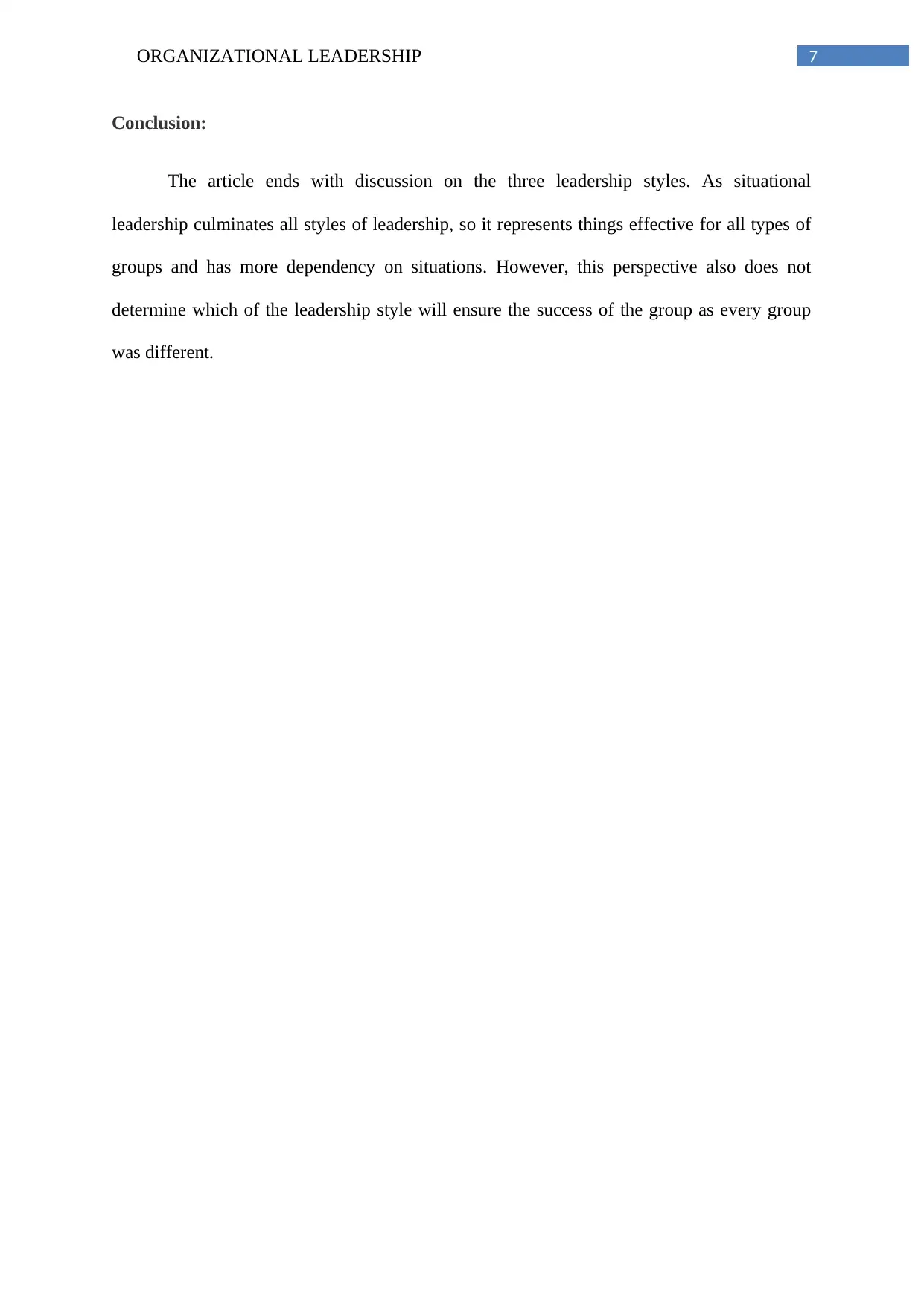
7ORGANIZATIONAL LEADERSHIP
Conclusion:
The article ends with discussion on the three leadership styles. As situational
leadership culminates all styles of leadership, so it represents things effective for all types of
groups and has more dependency on situations. However, this perspective also does not
determine which of the leadership style will ensure the success of the group as every group
was different.
Conclusion:
The article ends with discussion on the three leadership styles. As situational
leadership culminates all styles of leadership, so it represents things effective for all types of
groups and has more dependency on situations. However, this perspective also does not
determine which of the leadership style will ensure the success of the group as every group
was different.
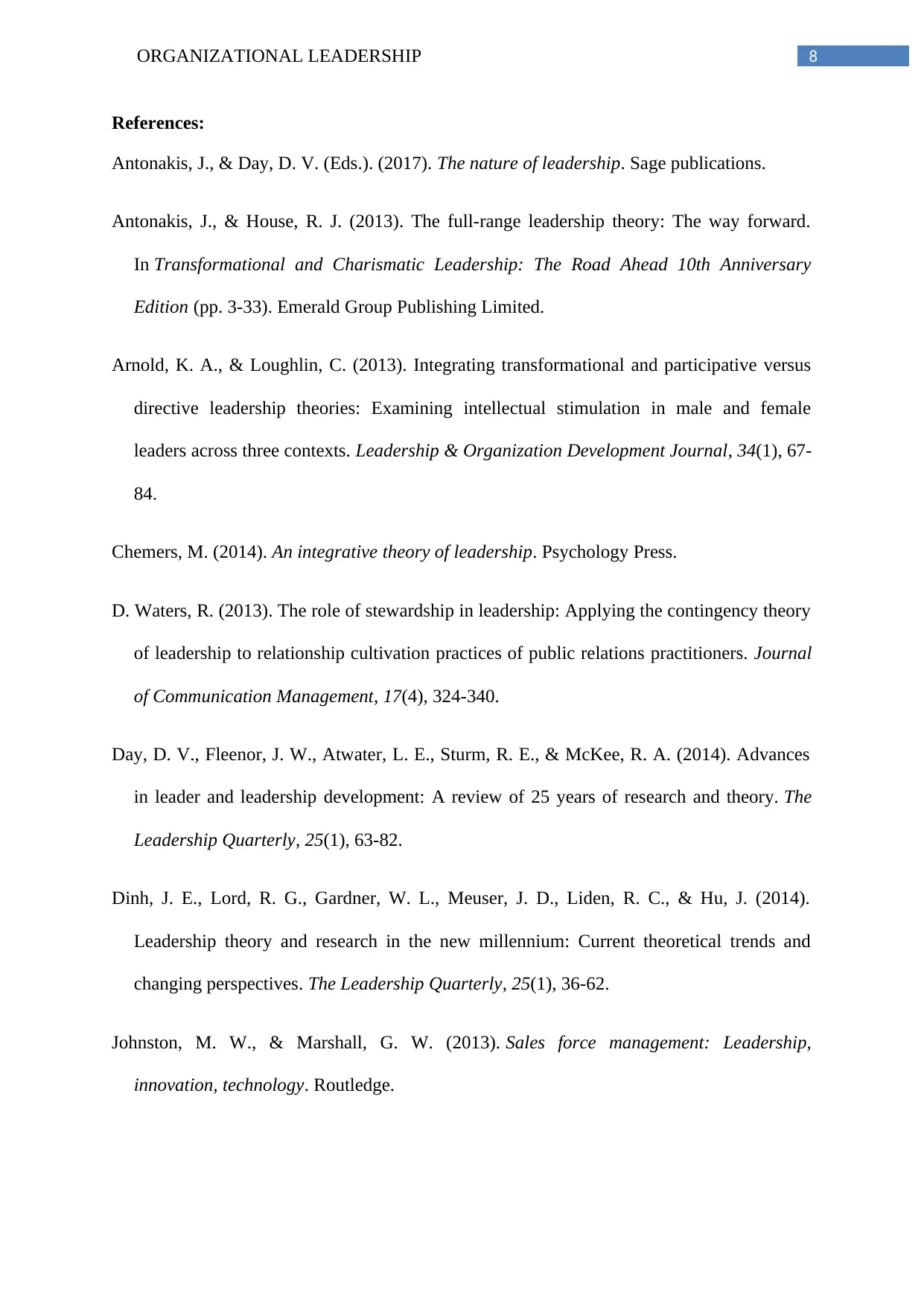
8ORGANIZATIONAL LEADERSHIP
References:
Antonakis, J., & Day, D. V. (Eds.). (2017). The nature of leadership. Sage publications.
Antonakis, J., & House, R. J. (2013). The full-range leadership theory: The way forward.
In Transformational and Charismatic Leadership: The Road Ahead 10th Anniversary
Edition (pp. 3-33). Emerald Group Publishing Limited.
Arnold, K. A., & Loughlin, C. (2013). Integrating transformational and participative versus
directive leadership theories: Examining intellectual stimulation in male and female
leaders across three contexts. Leadership & Organization Development Journal, 34(1), 67-
84.
Chemers, M. (2014). An integrative theory of leadership. Psychology Press.
D. Waters, R. (2013). The role of stewardship in leadership: Applying the contingency theory
of leadership to relationship cultivation practices of public relations practitioners. Journal
of Communication Management, 17(4), 324-340.
Day, D. V., Fleenor, J. W., Atwater, L. E., Sturm, R. E., & McKee, R. A. (2014). Advances
in leader and leadership development: A review of 25 years of research and theory. The
Leadership Quarterly, 25(1), 63-82.
Dinh, J. E., Lord, R. G., Gardner, W. L., Meuser, J. D., Liden, R. C., & Hu, J. (2014).
Leadership theory and research in the new millennium: Current theoretical trends and
changing perspectives. The Leadership Quarterly, 25(1), 36-62.
Johnston, M. W., & Marshall, G. W. (2013). Sales force management: Leadership,
innovation, technology. Routledge.
References:
Antonakis, J., & Day, D. V. (Eds.). (2017). The nature of leadership. Sage publications.
Antonakis, J., & House, R. J. (2013). The full-range leadership theory: The way forward.
In Transformational and Charismatic Leadership: The Road Ahead 10th Anniversary
Edition (pp. 3-33). Emerald Group Publishing Limited.
Arnold, K. A., & Loughlin, C. (2013). Integrating transformational and participative versus
directive leadership theories: Examining intellectual stimulation in male and female
leaders across three contexts. Leadership & Organization Development Journal, 34(1), 67-
84.
Chemers, M. (2014). An integrative theory of leadership. Psychology Press.
D. Waters, R. (2013). The role of stewardship in leadership: Applying the contingency theory
of leadership to relationship cultivation practices of public relations practitioners. Journal
of Communication Management, 17(4), 324-340.
Day, D. V., Fleenor, J. W., Atwater, L. E., Sturm, R. E., & McKee, R. A. (2014). Advances
in leader and leadership development: A review of 25 years of research and theory. The
Leadership Quarterly, 25(1), 63-82.
Dinh, J. E., Lord, R. G., Gardner, W. L., Meuser, J. D., Liden, R. C., & Hu, J. (2014).
Leadership theory and research in the new millennium: Current theoretical trends and
changing perspectives. The Leadership Quarterly, 25(1), 36-62.
Johnston, M. W., & Marshall, G. W. (2013). Sales force management: Leadership,
innovation, technology. Routledge.

9ORGANIZATIONAL LEADERSHIP
Lam, C. K., Huang, X., & Chan, S. C. (2015). The threshold effect of participative leadership
and the role of leader information sharing. Academy of Management Journal, 58(3), 836-
855.
Luo, H., & Liu, S. (2014). Effect of situational leadership and employee readiness match on
organizational citizenship behavior in China. Social Behavior and Personality: an
international journal, 42(10), 1725-1732.
McCleskey, J. A. (2014). Situational, transformational, and transactional leadership and
leadership development. Journal of Business Studies Quarterly, 5(4), 117.
Miner, J. B. (2015). Organizational behavior 1: Essential theories of motivation and
leadership. Routledge.
Onorato, M. (2013). Transformational leadership style in the educational sector: An empirical
study of corporate managers and educational leaders. Academy of Educational Leadership
Journal, 17(1), 33.
Ruggieri, S., & Abbate, C. S. (2013). Leadership style, self-sacrifice, and team
identification. Social Behavior and Personality: an international journal, 41(7), 1171-
1178.
Sethuraman, K., & Suresh, J. (2014). Effective leadership styles. International Business
Research, 7(9), 165.
Lam, C. K., Huang, X., & Chan, S. C. (2015). The threshold effect of participative leadership
and the role of leader information sharing. Academy of Management Journal, 58(3), 836-
855.
Luo, H., & Liu, S. (2014). Effect of situational leadership and employee readiness match on
organizational citizenship behavior in China. Social Behavior and Personality: an
international journal, 42(10), 1725-1732.
McCleskey, J. A. (2014). Situational, transformational, and transactional leadership and
leadership development. Journal of Business Studies Quarterly, 5(4), 117.
Miner, J. B. (2015). Organizational behavior 1: Essential theories of motivation and
leadership. Routledge.
Onorato, M. (2013). Transformational leadership style in the educational sector: An empirical
study of corporate managers and educational leaders. Academy of Educational Leadership
Journal, 17(1), 33.
Ruggieri, S., & Abbate, C. S. (2013). Leadership style, self-sacrifice, and team
identification. Social Behavior and Personality: an international journal, 41(7), 1171-
1178.
Sethuraman, K., & Suresh, J. (2014). Effective leadership styles. International Business
Research, 7(9), 165.
Secure Best Marks with AI Grader
Need help grading? Try our AI Grader for instant feedback on your assignments.
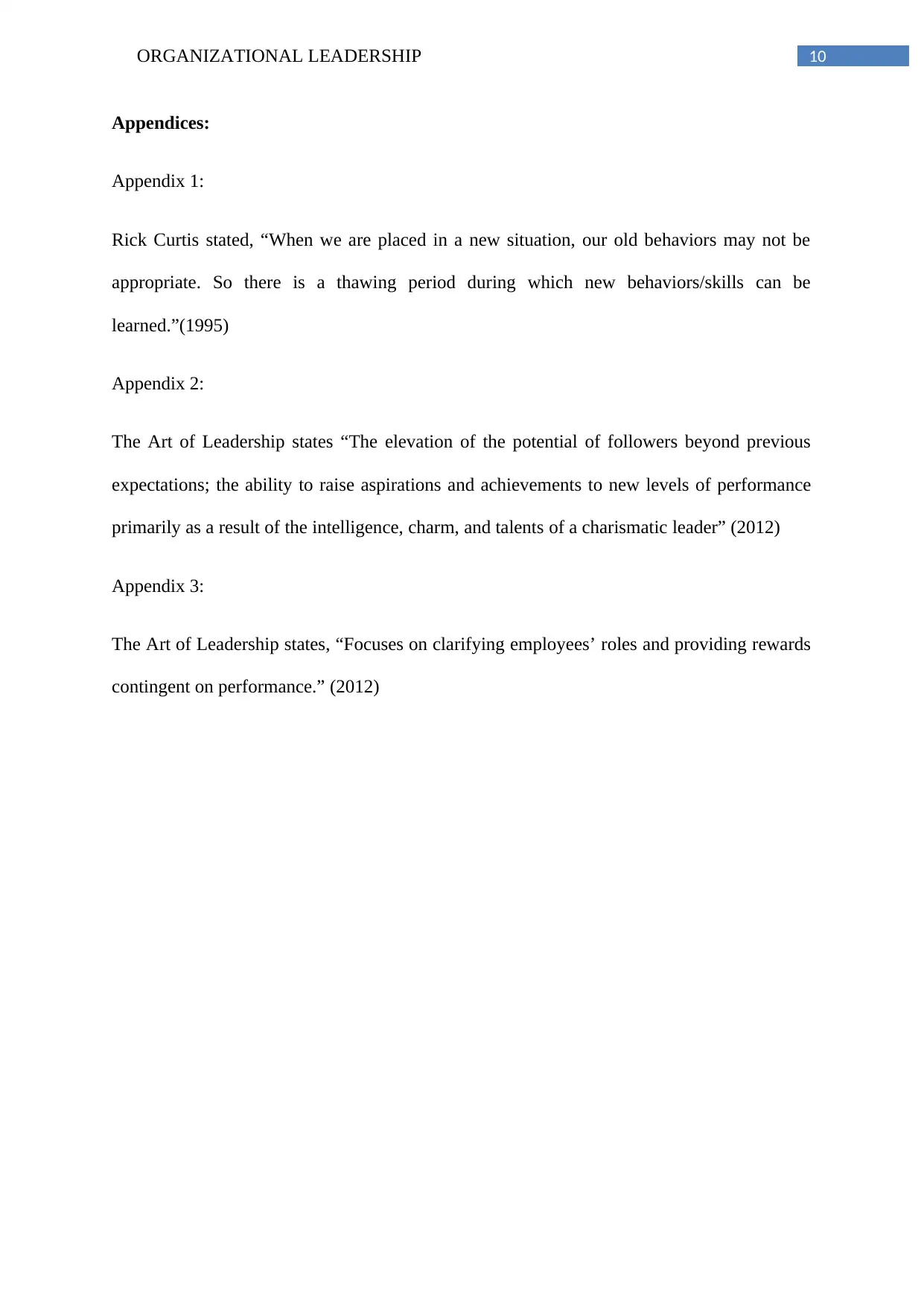
10ORGANIZATIONAL LEADERSHIP
Appendices:
Appendix 1:
Rick Curtis stated, “When we are placed in a new situation, our old behaviors may not be
appropriate. So there is a thawing period during which new behaviors/skills can be
learned.”(1995)
Appendix 2:
The Art of Leadership states “The elevation of the potential of followers beyond previous
expectations; the ability to raise aspirations and achievements to new levels of performance
primarily as a result of the intelligence, charm, and talents of a charismatic leader” (2012)
Appendix 3:
The Art of Leadership states, “Focuses on clarifying employees’ roles and providing rewards
contingent on performance.” (2012)
Appendices:
Appendix 1:
Rick Curtis stated, “When we are placed in a new situation, our old behaviors may not be
appropriate. So there is a thawing period during which new behaviors/skills can be
learned.”(1995)
Appendix 2:
The Art of Leadership states “The elevation of the potential of followers beyond previous
expectations; the ability to raise aspirations and achievements to new levels of performance
primarily as a result of the intelligence, charm, and talents of a charismatic leader” (2012)
Appendix 3:
The Art of Leadership states, “Focuses on clarifying employees’ roles and providing rewards
contingent on performance.” (2012)

11ORGANIZATIONAL LEADERSHIP
1 out of 12
Related Documents
Your All-in-One AI-Powered Toolkit for Academic Success.
+13062052269
info@desklib.com
Available 24*7 on WhatsApp / Email
![[object Object]](/_next/static/media/star-bottom.7253800d.svg)
Unlock your academic potential
© 2024 | Zucol Services PVT LTD | All rights reserved.





